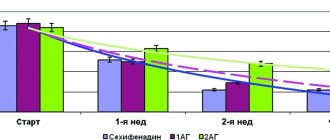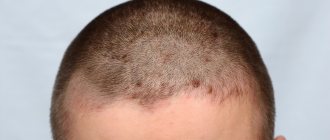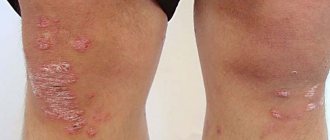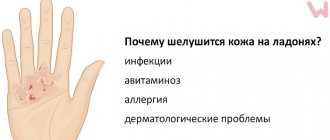Drug toxicoderma is a type of toxicoderma. It is an inflammatory process of the skin of a toxic-allergic nature, manifested by various types of rashes. It develops under the influence of an allergen that enters the skin through the blood, and is often accompanied by damage to the mucous membranes. The most complex forms of toxicoderma are Stevens-Johnson and Lyell syndromes. They are characterized by acute bullous lesions of the skin and mucous membranes.
The Department of Dermatovenereology CELT invites you to undergo diagnostics and treatment for drug-induced toxicoderma in Moscow. We have been providing paid medical services in the capital’s market for more than 25 years and have everything necessary for accurate diagnosis and treatment in accordance with modern international standards.
At CELT you can consult a dermatologist.
- Initial consultation – 3,500
- Repeated consultation – 2,300
Make an appointment
Causes of toxic dermatitis
Toxic dermatitis can be caused by almost any drug, but the most common causes are antibiotics, nonsteroidal anti-inflammatory drugs, and drugs used to treat epilepsy. A drug rash appears a short time after starting to take the medication, and in most cases goes away immediately after discontinuation, but sometimes it takes two to three weeks. Some types of rashes are severe and may even be life-threatening and require hospital treatment, even if the patient is no longer taking the drug that caused the dermatitis.
Most often the reaction is caused by:
- Amoxicillin
- Biseptol
- Ampicillin
- Penicillin
- Blood products
- Cephalosporins
- Quinidine
- Gentamicin
- Diuretics
- Heparin
Cross-reactions occur between penicillins and cephalosporins, as well as between some anticonvulsants. For example, if a patient is allergic to ampicillin, cefazolin will also cause pathological changes in his skin.
Toxic skin damage is based on processes such as:
- Allergic reaction,
- Accumulation of toxic drugs in the dermis,
- Increased skin sensitivity to sunlight due to the influence of the drug,
- An interaction between two or more substances.
Drug rashes are more common in older people and affect women more than men. Other risk factors include:
- Taking antibiotics for a viral infection
- Weakening of the immune system due to some current disease, due to taking a drug,
- Malignant disease.
Types of disease
By type, toxicerma in children can be divided into several types:
• Autotoxic. This type of toxicoderma occurs due to the release of toxins by the human body itself. This happens mainly due to the presence of serious diseases of the kidneys, liver, intestines, stomach, or cancer.
• Drug-induced, or in other words, drug-induced toxicoderma. This type occurs when a drug is introduced into the body, which contains a substance that the sick child’s body perceives as hostile and tries to reject it with a similar reaction.
• Nutritional. Such toxicoderma occurs when the body has an allergic reaction to certain foods or food additives and dyes included in food products.
• Professional. It occurs when the body reacts to constant exposure to toxic substances: varnishes, paints, solvents, other chemicals and even ordinary paper dust.
Allergens can enter the body with food, through intramuscular and intravenous injections, through the respiratory system and through the pores of the skin in direct contact with its surface.
Symptoms of toxic dermatitis
Most rashes are symmetrical, that is, evenly distributed on both halves of the body. Also, this type of skin lesion does not cause any other symptoms. Only in some cases, a drug rash may be accompanied by itching or skin sensitivity.
- Eczematous rashes. This type is most common and accounts for 90% of all toxic skin processes. Its characteristic feature is small elements of a rash on reddened skin. They can be flat or raised. Sometimes you can see blistering and pus formation. Drugs that can cause this type of damage:
- Urticaria is the second most common type of drug rash. At its core, it is toxic-allergic dermatitis, which usually occurs in children, has a characteristic appearance, as shown in the photo, and treatment is aimed at eliminating the underlying cause and combating allergies. The rash is small pale pink bumps that can merge with each other, and itching is also noticeable. Main provoking drugs:
- Photosensitivity. Some medications make the skin especially sensitive to ultraviolet light. This can lead to an itchy sunburn if you go outside without adequate protection. This toxic dermatitis appears more often in adults, on open areas of the skin, on the face and hands, as shown in the photo. Medicines that affect photosensitivity:
- Erythroderma. In this condition, the entire surface of the body becomes red and itchy. Characteristically, there is pronounced peeling, the skin is hot to the touch, and the overall body temperature may rise, and chills occur. This occurs because epithelial cells die too quickly due to an inflammatory response. All drugs that cause a rash can also lead to erythroderma. This type of reaction can be dangerous and requires medical attention and immediate treatment. If left untreated, complications such as infection, loss of nutrients, dehydration, and heart failure may develop.
- Toxic epidermal necrolysis, or Stevens-Johnson syndrome. These two conditions differ only in the area of skin affected: if a large surface is affected, then it is epidermal necrolysis. The disease causes large, painful blisters to form that appear with slight pressure on the skin. They burst open, leaving open, extremely painful, weeping sores. Among the drugs that can cause this condition are sulfonamides, non-steroidal anti-inflammatory drugs, antiepileptic drugs, allopurinol and the HIV drug nevirapine. This disease is rare and dangerous; it is treated in a hospital.
- Rash while taking anticoagulants. Some blood thinners, such as warfarin, can lead to skin necrosis caused by anticoagulants. As a result, the deep layers of the skin die. This occurs when the patient begins to take large doses of the drug. Middle-aged women who are obese are more often affected by the condition. The first symptoms are pain and redness of the skin area. Then clear boundaries of the lesion are formed, it becomes dense, swells, and becomes covered with small (petechial) hemorrhages. The process progresses to the form of a necrotic ulcer, which slowly heals to form a scar. The condition can be dangerous; if you suspect it, you should immediately seek medical help.
| Penicillins (ampicillin, amoxicillin) |
| Sulfur-containing drugs (sulfonamides, sumatriptan, celecoxib, indapamide, furosemide) |
| Cephalosporins |
| Anticonvulsants (finlepsin, lamictal, topiramate) |
| Allopurinol |
| Non-steroidal anti-inflammatory drugs (ibuprofen, aspirin, diclofenac) |
| ACE inhibitors (captopril, enalapril, lisinopril) |
| Antibiotics, especially penicillin |
| Anesthetics |
| Tetracycline, doxycycline |
| Sulfonamides |
| Antifungal (griseofulvin) |
| Antihistamines (suprastin, tavegil) |
| Retinoids (isotretinoin) |
| Statins (atoris, crestor, vasilip) |
| Diuretics (indapamide, hypothiazide) |
Diet
The occurrence of an acute allergic reaction during toxicoderma requires a complete revision of the diet in order to reduce allergic tension.
- Within 1 month after toxicoderma, it is not recommended to consume foods that can irritate the mucous membranes of the digestive organs and require effort on the part of the body to assimilate them;
- It is recommended to consume plant products and dairy dishes, but no more than 7 days in a row;
- A positive effect on the nutrition of the skin and the whole body during the development of toxicoderma has the inclusion of green salad, nettles, onions and a small amount of garlic (with the core previously removed) into the diet;
- boiled white meat (chicken, rabbit) and low-fat fish should be introduced into the diet gradually, starting with minimal portions;
- for toxicoderma of various etiologies, it is necessary to maintain a water regime with plenty of drinking, excluding drinks such as tea and coffee. Non-carbonated mineral water has a positive effect;
- toxicoderma can occur when consuming alcoholic beverages, chicken eggs, strawberries, honey, so these products should be excluded from the diet;
- in the acute stage of the disease, you should avoid vegetable and fruit juices prepared in industrial enterprises. It is best to prepare juices yourself, avoiding exotic fruits and vegetables.
It should be noted that today toxicoderma can be treated quite effectively, but after remission, as well as in the stage of exacerbation of the disease, mandatory supervision by a specialist is recommended. This will protect the body as much as possible from the negative effects of the allergen.
Toxic dermatitis in a child
The toxic type of erythema is dermatitis, which develops in full-term newborns (see photo) and is not a pathology. The rash usually appears in the first days and disappears within a week. This condition occurs in up to 50% of infants and affects the cheeks, chest, arms and legs, but never occurs on the palms and soles. The elements of the rash are red, small, raised, and may be filled with fluid. They resemble pimples full of pus, but in reality there is no pus or bacterial inflammation. This is not an infectious disease. Since no pathological symptoms occur and the rash goes away on its own, erythema toxicum of newborns does not require treatment. If, against the background of rashes, a child becomes restless, eats and sleeps poorly, cries, or develops a fever, it is necessary to consult a doctor, since such signs are not typical for this transient condition and may indicate a more serious illness.
Common toxicoderma
This form of the disease is more serious. Its symptoms can be life-threatening. Common toxicoderma is characterized by the following symptoms:
- the appearance of a rash;
- temperature increase;
- chills;
- digestive disorders.
If you stop taking the allergen immediately after the allergy appears, you can easily break the vicious circle. The symptoms of this type of disease are similar to other processes - urticaria, lichen Giber, erythema, lupus. Therefore, it is very important to contact qualified specialists.
Treatment of toxic dermatitis
In most cases, toxic dermatitis goes away on its own when the patient stops taking the medicine that caused it, so the question of how to treat it does not arise, no special therapy or diet is required. However, no medications can be canceled on their own, especially when it comes to serious conditions such as epilepsy, diabetes, and arterial hypertension. If a skin reaction occurs, consult a doctor. This is especially important when the patient is taking many different medications. By discontinuing it sequentially, the doctor will help detect the allergenic drug. Of course, if necessary, medications will be prescribed that will take over the functions of the canceled ones.
Sometimes the medicine that caused the reaction is vital for the patient and cannot be replaced by any other. Then, if it is only a rash, treatment may not be canceled, but antiallergic therapy may be prescribed and closely monitored in order to stop the development of complications in time. This should be done by a doctor; it is dangerous to continue taking an allergenic drug without medical supervision.
Treatment with medications
- Antihistamines. They help cope with itching, and first generation antihistamines such as suprastin and diphenhydramine are especially effective. With any allergy, the substance histamine is concentrated in the tissues, which irritates pain receptors, leading to itching. Drugs in this group block the release of histamine from cells.
- Ointments with glucocorticoids. The active substance, similar in structure to the hormones of the adrenal cortex, penetrates the dermis and suppresses the inflammatory response. Redness decreases, the rash fades and disappears, the itching goes away. Hello, long-term use of hormonal ointments can cause side effects, both local, in the form of skin atrophy, and general (increased blood pressure, blood sugar levels, obesity, osteoporosis). However, for toxic dermatitis they are used for a short course, it is quite safe.
- If there is no effect from antihistamines and local hormonal ointments, glucocorticosteroid hormones are prescribed in the form of tablets. They help quickly relieve general symptoms of inflammation.
- If a severe drug reaction occurs, such as erythroderma, toxic epidermal necrolysis, or warfarin necrosis, the condition is treated in a hospital under medical supervision. Sometimes the patient is admitted to a burn unit where facilities are in place to prevent infection. This is due to the skin losing its protective properties.
Fixed toxicoderma
Symptoms of fixed toxicoderma include the following:
- round or oval spots reaching a diameter of 3 centimeters;
- spots that have a brown tint on the 5th day from the moment of appearance;
- the bubble in the middle is an optional feature.
In order to stop the appearance of these rashes, you must stop taking the causative drug. In this case, after a week the skin rash will disappear without a trace. But if a person starts taking this medicine again, the rash will appear again. Moreover, in most cases they appear in the same places where they were before.
Sometimes a rash appears on the oral mucosa, but without inflammatory signs. In this situation, subjective symptoms are less pronounced. Often with toxicerma, disorders associated with the central nervous system are observed. Therefore, the following symptoms may appear:
- irritability;
- depression;
- insomnia;
- weakness;
- central itching of the skin.
Prevention of toxic dermatitis
An allergic reaction can occur from almost any medicine, although some are more likely to cause an allergic reaction. This means that when you take it for the first time in your life, you cannot predict whether a skin rash will develop or not. The only effective way to prevent toxic dermatitis - if it has already developed once in response to taking a drug - is not to take that drug again.
- It is important to carefully answer doctors’ questions and actively communicate your allergies at your appointment. The medical record must indicate intolerance. Be sure to also inform your dentist.
- If the reaction is severe, with angioedema or a sharp decrease in blood pressure (anaphylactic shock), it is advisable to wear a bracelet that reports this.
- In case of any ailment, it is necessary to follow the doctor’s recommendations and not self-medicate. For example, if a patient unknowingly begins to treat a viral infection with an antibiotic, the likelihood of developing toxic dermatitis is extremely high. A well-known symptom is that a rash appears when ampicillin is taken for infectious mononucleosis (kissing disease), suggesting a sore throat.
Diagnostics
Differential diagnosis is based on the clinical picture.
First of all, anamnesis is collected to determine the cause of the disease and a visual examination of the patient, since with toxicoderma, an analysis to identify the allergen is very often not able to give a 100% result.
If necessary, a biopsy and histological examination of the source material can be performed. It must be taken into account that biopsy in the gastrointestinal tract may be accompanied by increased sensitivity. A biopsy of the skin covered with a rash reveals lymphocytic and eosinophilic infiltration.
To exclude the infectious-bacterial nature of toxicerma, it is recommended to diagnose bacterial seeding of scrapings from the affected area of the skin. In case of severe development of the disease, a coagulogram, blood and urine tests may be performed.
Medicines
In addition to the listed drugs for local treatment, there are a number of other medications for systemic treatment, each of which performs its own function.
So, to remove toxins through the genitourinary system, I use the following drugs for oral administration:
- Furosemide;
- Dufolac;
- Portolac;
- Veroshpiron.
To suppress the aggressive immune process against allergens, the following is used intravenously:
- calcium gluconate solution;
- sodium thiosulfate solution;
- calcium gluconate (intramuscular).
Corticosteroid drugs for severe forms of toxicerma include:
- Descamethasone;
- Hydrocortisone;
- Prednisolone.
To restore damaged mucous membranes, use:
- Strepsils;
- Kamistad;
- Metrogil.
Traditional medicine
After prescribing treatment on an outpatient basis, procedures are added to the recovery process to help “calm” the affected areas on non-mucosal surfaces. To subside the itching, you can use a bath with the addition of grated oats.
This mixture is prepared as follows:
- Rub 200 g of oatmeal with your hands to a powder;
- pour 1 liter of water;
- simmer over low heat for 1 hour;
- add to bath.
In addition, decoctions and compresses from:
- chamomile;
- oak bark;
- St. John's wort;
- nettle;
- successions.
After taking a bath, apply baby cream to dry skin to moisturize the skin. The skin should not be allowed to dry out. To prevent the top layer from peeling off, creating new wounds, it should be lubricated with olive and peach essential oils.








